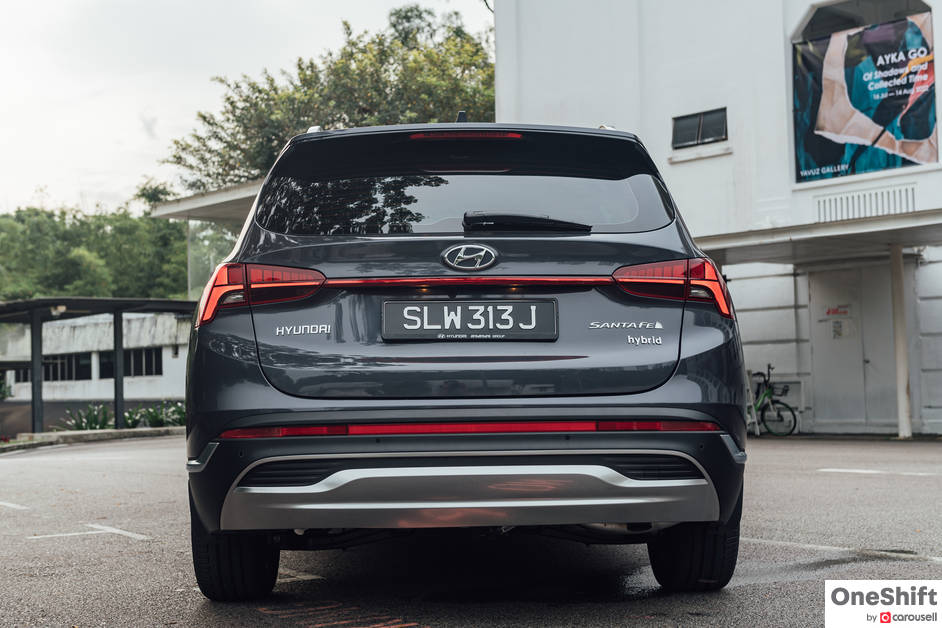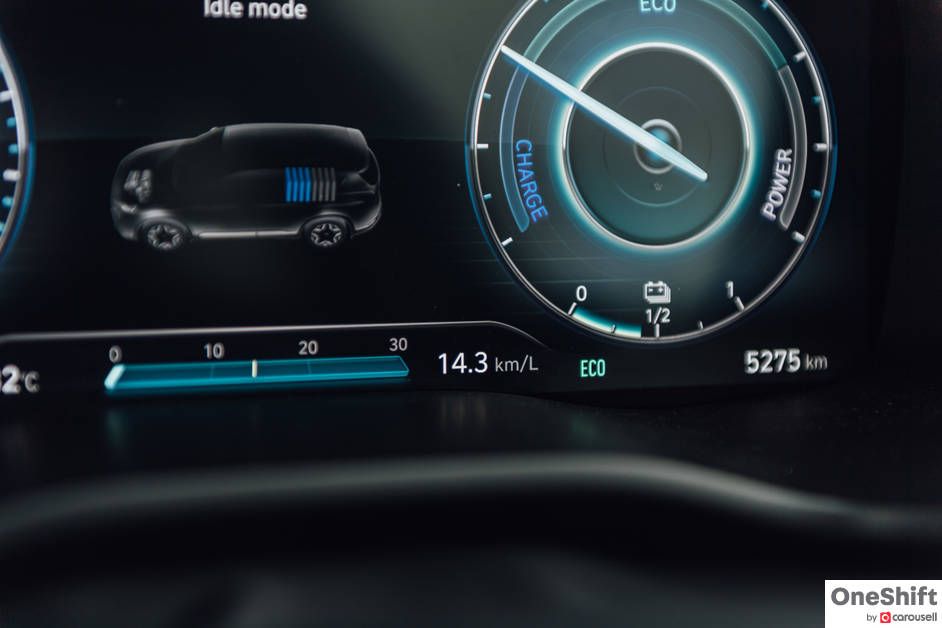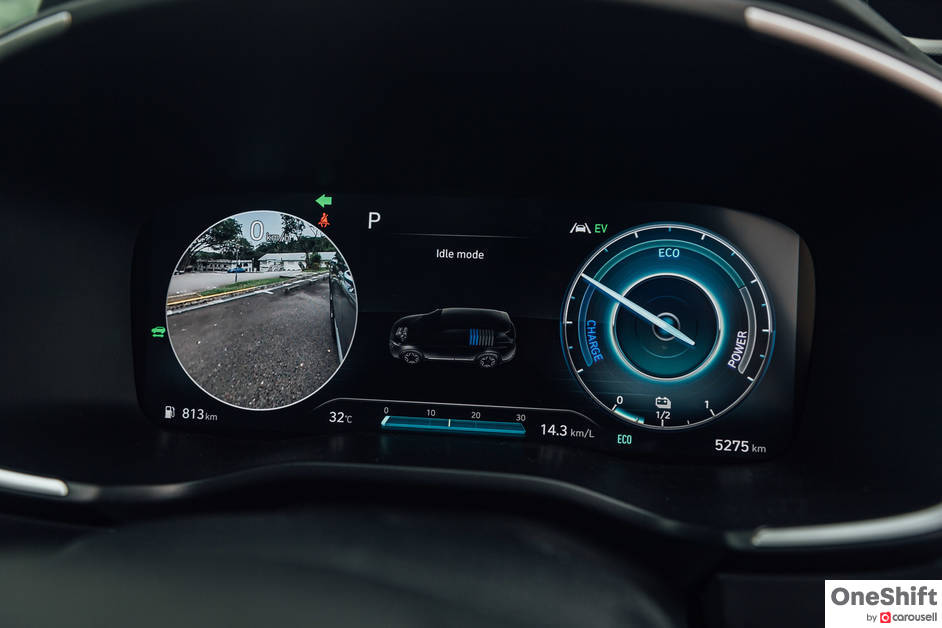Hyundai Santa Fe Hybrid Sunroof Review: The Jetsons' Family Hauler
The facelifted 4th generation Santa Fe adopts Hyundai's bold design language. Does this large 7-seater SUV make sense for the Singapore market?







Since its launch in 2001, the Santa Fe is the longest-running SUV in the Hyundai model line-up. Truth be told, earlier generations hardly left a strong impression and they came with large engines (2.7-litre V6s) which resulted in high road tax bills. Some Singaporeans may also identify the pre-facelift 4th generation Santa Fe as part of the Singapore Police Force fleet.

The facelifted 4th generation Santa Fe Hybrid tested here is immediately recognisable as a Hyundai. It adopts a prominent front-end where the wide 3D grille connects with the front headlamps. The main headlamp unit is separated from the signal light but are ‘connected’ by a unique T-shaped design. It makes the Santa Fe fiercer and menacing. In this shade of Lagoon Blue, the gloss-black 3D grille, headlamps and matte silver bumper trim form a bold aesthetic look.

The car’s length is accentuated by the sharp shoulder crease line that runs from the front headlamp to the rear light cluster. The scalloped doors serve to reduce the bulkiness of the car but also creates a sophisticated and elegant design.

It is a clean design at the rear. A reflector strip links the rear LED taillights and you can tell that this car is wide at 1.9m.

With a car of this size and weighing nearly 1.8 tonnes, one may wonder if a turbocharged 1.6-litre hybrid drivetrain provides sufficient power. Hyundai’s new Smartstream hybrid powertrain is excellent and is utilised in the larger SUVs like the Santa Fe and Tucson. The 1.6 T-GDi engine is paired with a 44.2kW electric motor and a 1.49 kWh lithium-ion polymer battery. Standalone, the engine produces 180hp and 265Nm but in hybrid guise, the combined power output increases to 230hp and 350Nm. Speed is unlikely to be the focus for owners, but the Santa Fe Hybrid can reach 100 km/h in 8.9s, up to a maximum velocity of 187 km/h. An option for AWD would be welcome for a car of this weight and size.

It is worth highlighting that Hyundai’s 1.6 T-GDi engine is the first mass production engine to incorporate Continuously Variable Valve Duration (CVVD) technology. Till date, we have Continuously Variable Valve Timing (CVVT; controls when valves are opened and closed) and Continuously Variable Valve Lift (CVVL; controls how much the valves are opened). CVVD allows the engine to have an infinite combination of valve-open durations across the entire rev range. Hyundai claims that this improves economy by 5%, performance by 4% and reduces emissions by 12%. Great technology!

On the go, the Santa Fe is composed and refined. The 6-speed automatic is paired well with the hybrid drivetrain. The car determines the drive mode – Full EV/Hybrid/Charging – to deliver the best fuel economy or performance. Hyundai does not allow the driver to specifically select Full EV mode but it does not matter as the car does a great job of transitioning across the various modes automatically. What is particularly impressive is that the engine cutting in/out is seamless with good control of NVH by Hyundai. An observation though – the engine is slightly louder in the Korean-made Santa Fe’s cabin than the Czech-made Tucson.

Over the 3-day test, I covered a total of 210 km with a good mix of highway/city and spirited/eco driving. For a giant like the Santa Fe, the electrified hybrid drivetrain returned a stellar fuel economy of 13.5 km/l and the fuel gauge barely dropped by an eighth of a tank. Dads and Mums no longer need to be worried about hefty petrol bills while rushing for the school run.

The interior of the Santa Fe Hybrid feels very well built and is finished with high quality and luxurious materials. The dashboard has a premium soft-touch feel and the seats come with factory-fitted soft Nappa leather. Hyundai’s bold design language can also be found in the cabin where there are textured designs in the form of quilted seats and 3D speaker covers. Other standard kit includes a large tinted panoramic sunroof that extends to the end of the 2nd row seats. The 1st section of the sunroof can also be opened which would keep the younger children intrigued.

Ergonomics and comfort take priority in the Santa Fe Hybrid. The design of the centre console is intuitive with well-sized and easy to use shift-by-wire gear selector buttons and aircon controls. Passengers do not need to worry about reduced legroom as the hybrid battery has been reallocated to the bottom of the passenger seat with no encroachment into cabin space. Front passengers get ventilated front seats whilst rear passengers get in-built sunshades.

3rd row legroom is acceptable and the 2nd row seats can be adjusted forward for more legroom for longer journeys, if required. There are also separate aircon controls for 3rd row passengers which is important for our tropical weather.

With all 3 rows up, trunk space is rather limited at only 130 litres, but this is not unexpected for a 7-seater. The car is versatile and can configured in different seating arrangements. If all the rear seats are folded flat, the trunk space expands to a cavernous 782 litres.

Other features that come standard on the Santa Fe Hybrid include an 8-inch touchscreen multimedia system with Apple CarPlay and Android Auto. Wireless charging also comes standard. There is a full HD head-up display that integrates critical information such as speed, fuel level and driver assistance information. The instrument panel is a 12.3-inch full LCD cluster that is clear and sharp and comes with different pre-set gauge designs for Eco, Sport and Smart modes. The Eco theme gauge design looks the classiest in my opinion.

Hyundai’s advanced driver assistance systems, termed Smartsense, is well engineered and integrates seamlessly into the driving experience. It is a long list of 10 active safety and driving assistance features and notable ones include – Forward Collision-Avoidance with Junction Turning, Rear Cross-traffic Collision Assist, Blind-spot View Monitor and Safe Exit Assist. The sensors did manage to detect a golden retriever that was going to cross when I was reversing out of the driveway and slowed the car steadily (I did see the dog too!). Admittedly, I did turn off the Blind-spot Collision Warning indicators (as with my own car) as they usually err on the side of caution. Thankfully, the Smartsense safety warnings do not beep as loudly as when the car ignition is turned on.

At $235,999, the Santa Fe Hybrid Sunroof is the model to go for. The additional 8 grand for the sunroof brightens the cabin and increases the premium feel of the car. The Santa Fe Hybrid is not small change for families at current COE prices and sales of this car may be slower. Putting pricing aside, the car presents an excellent package with a good hybrid drivetrain, plush and comfortable interior and good fuel economy. It would make a reliable and practical daily drive and a good travel companion for road trips up North.
Refined 7-seater SUV for the school run and road trips up North, but hampered by high COE prices
Photos by Horizon Drivers' Club








Get the Best Price for your used car
from 500+ dealers in 24 hours

- Convenient and Hassle-Free
- Consumer Protection
Transparent Process
With No Obligation













